
views
X
Trustworthy Source
Civil Law Help Center
Nonprofit law firm dedicated to civil legal services to all people
Go to source
Evaluating the Complaint

Determine how long you have to respond. The summons you receive will tell you how many days you have to respond to the lawsuit. If you don't file a written answer in court within that deadline, the person who sued you can get a default judgment for everything they've asked for, even if some of the statements they made aren't true. While the deadline differs among states and depends on the type of lawsuit filed, it's typically at least 15 days, starting on the date you received the summons and complaint. The number of days listed on the summons are calendar days, not business days. If the deadline date falls on a weekend or holiday, you typically need to file your answer on the business day immediately before that day. Even if you have an entire month to file your answer, start on it immediately. You never know what might happen in the meantime and you don't want to miss filing your answer.Tip: If you don't remember the exact date you received the summons and complaint, call the court clerk's office at the number listed on the summons. Give them the case number and ask what date the summons and complaint were served.
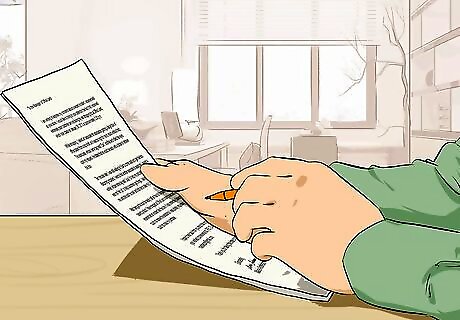
Read the complaint carefully to figure out who's suing you and why. The complaint lists the name of the person or company suing you as the plaintiff. It then lists factual allegations the plaintiff is making against you and asks the court for a specific amount of money, or to order other actions. You will need to respond to each of these allegations in your answer. The allegations will be listed in numbered paragraphs. Take each numbered paragraph separately and ask yourself if the fact is true or not. If it's not, make note of what's wrong about it. This is all information that you'll need to include in your answer. If you have documents that might prove that one of the allegations isn't true, make a note of it. You can attach that document to your answer to support your argument.Tip: Make a copy of the complaint that you can markup and use for your own notes. That way, the original remains clean and intact.

Identify the court where the lawsuit was filed. The name and location of the court where the lawsuit was filed are listed on the summons. Find out where the court is. If it's far away from you, go to the website for your state's courts and see if there's a closer court where the plaintiff could have sued you. If the court is located far away from you, it may not have jurisdiction over you. Even if it does, there may be a more convenient location where the case could be heard. For example, if someone is suing you over property damage and injuries from a car accident, they can sue you in the county where the car accident occurred. However, if you happened to be visiting family on the other side of the state when the accident occurred, you may be able to get the case moved to a court closer to you. On the website for your state's courts, you can also find out what types of cases that court usually hears. If the plaintiff is suing you for something different, you may have an argument that the court doesn't have jurisdiction over the claim. This is unlikely, however, because state courts typically have very broad jurisdiction. That doesn't mean you shouldn't look into it, though, just to be sure.Tip: If you don't raise any questions about the court's jurisdiction in your answer, you may not be able to bring them up again. When in doubt, go ahead and include a statement that the court doesn't have jurisdiction over you. If it turns out the court does, you can abandon that claim.

Decide if you have any claims against the person who sued you. Often, an incident that gives rise to a lawsuit results in damages on both sides. If the person who sued you owes you any money, you can list those in your answer. For example, if someone sued you because the two of you got into a car accident, you may have had damage to your car and injuries as well. You can ask the court to make the plaintiff pay you for the damages you sustained as a result of the wreck. Counterclaims may also occur in contract situations. For example, if you have a contractor sue you because you didn't pay them for work they did, you might have a counterclaim that the work they did was substandard and you had to hire another contractor to redo their work.

Gather documents related to the lawsuit's allegations. If you listed any documents that might prove that any of the lawsuit's allegations are not true, find those documents so you can attach them to your answer. Make at least 3 copies of any document you plan to attach to your answer. Keep the originals for your own records. If you know of the existence of documents but don't have any way of getting them, write down who might have them. If the lawsuit goes to trial, you can have the court order whoever has those documents to produce them. If you're making claims against the person who sued you, see if you have documents that would support your claims as well.

Talk to the person who sued you and negotiate a settlement if possible. It may be that you read over the complaint and realized that the plaintiff was totally in the right. In that situation, it's probably better for you to try to work out a settlement with the person, rather than drawing out the process through the courts. Even if you think you could successfully fight the lawsuit, you could also decide that it's not in your best interests to do so – especially if the plaintiff is asking for a relatively small amount of money. While it's fine to call up the plaintiff (or their attorney), any offer to settle the lawsuit should be made in writing. Send them a brief letter outlining your settlement offer.Tip: Even if you're talking to the person who sued you and believe a settlement is possible, you should still work on your answer and file it with the court. Otherwise, the person who sued you can get a default judgment against you if settlement negotiations fall through.
Drafting Your Answer

Search for forms or templates to format your answer. An attorney would draft an answer from scratch. If you're not going to hire an attorney, however, many courts have forms or templates that you can use for your answer. There may even have been one included with your summons and complaint. Check the website of your state's courts to see if there are forms available. Legal aid organizations in your state may also have forms available that you can use if you want to answer a summons without an attorney. Go to https://www.lsc.gov/what-legal-aid/find-legal-aid to find legal aid offices near you and get links for their websites. There may also be form banks at the local public law library, typically located in your local courthouse. Call the court clerk at the number listed on your summons for more information.Tip: If you can't find any forms or templates you can use, go to the court clerk's office and ask them for copies of answers filed in other lawsuits. You can use these to get a sense of the type of language lawyers use when drafting their answers.
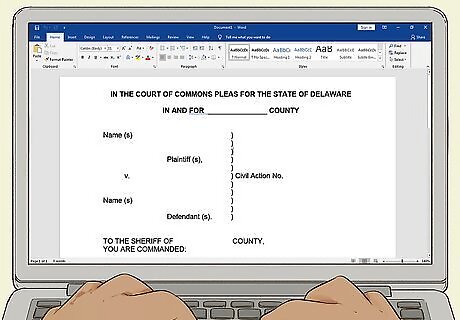
Copy the heading from the complaint if you don't have a form. The top third of the complaint lists the name and location of the court, the "style" of the case (the names of the parties to the case), and the case number. The particular format of this heading should be copied exactly. It will be exactly the same for every court document filed in every case that court hears. Even the spacing of the heading can be important. However, don't worry if you can't get it exactly right. Just get as close as possible. Make sure you've copied all the same information in roughly the same area of the page.
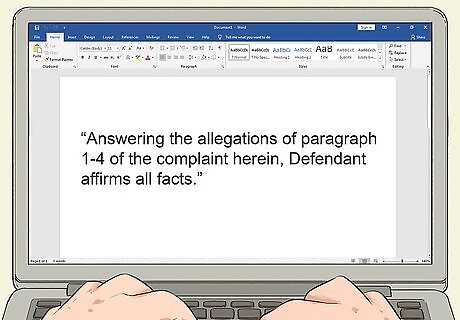
Admit or deny each of the facts listed in the complaint. Follow the same formatting as the complaint, numbering your paragraphs. For each numbered paragraph in the complaint, type "Admitted" if you admit the allegation or "Denied" if you deny the allegation. If you don't have enough information to know whether the fact is true or false, respond with "Lack enough information to respond to Plaintiff's allegations." Don't guess when you respond to any of the allegations. Any allegation that you admit is something the plaintiff doesn't have to prove in court. If you deny an allegation or say you lack enough information, they will be required to prove in court that the allegation is true. You may find that some allegations are partially true and partially false. In this case, respond by writing "Admitted in part and denied in part." Then include a short sentence regarding the part of the allegation that you deny.Tip: It's common to refer to yourself in third person as the "Defendant" in legal documents. If you do this, always capitalize the word "Defendant" because it refers to a specific person (you). However, there's no requirement that you write this way. You can also write in the first person if it makes you feel more comfortable.
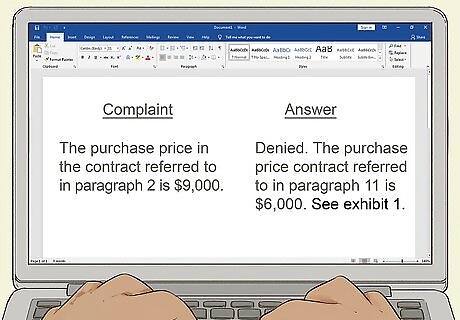
Include supporting documents as "Exhibits" to your answer. If you gathered any documents to support any of the statements you made in your answer, you can attach them to the answer as "Exhibits" and refer to them in your answer. Exhibits are typically numbered sequentially in the order they are first mentioned in your answer. You can write the number of the exhibit directly on the copy of the document, just make sure you're not covering up anything important. When you refer to exhibits in your answer, write something like "See Exhibit 1."
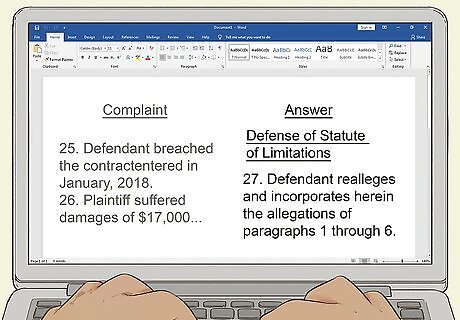
List any defenses or counterclaims you have. After you've responded to each of the allegations, include any defenses you might want to raise. Keep in mind you don't necessarily have to pursue all of these defenses. However, you may lose the right to claim some of them if you haven't mentioned them in your answer. After your defenses, describe any counterclaims you have against the plaintiff. When you discuss your counterclaim, you're required to ask the court for a specific amount of money. Be realistic with your valuation. Even if you're able to prove the facts of your counterclaim, the court will only award the amount of money that would "make you whole." For example, if you incurred $5,000 in expenses to repair damages caused by the plaintiff, the judge would not award you $15,000 just because you seem like a nice person.
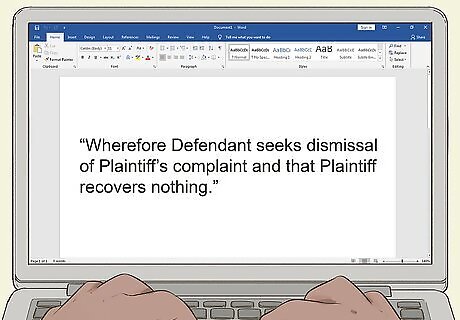
Close with a "wherefore" clause asking the court to dismiss the lawsuit. The defendant's "wherefore" clause is usually similar for any answer. However, the specific wording may depend on what you claimed in your answer and whether you had any counterclaims. For example, if you denied all or most of the plaintiff's allegations, your clause might read "Wherefore Defendant seeks dismissal of Plaintiff's complaint and that Plaintiff recovers nothing." If you have counterclaims, you might also include a statement that the court "award Defendant such other and further relief as the Court deems just and equitable."
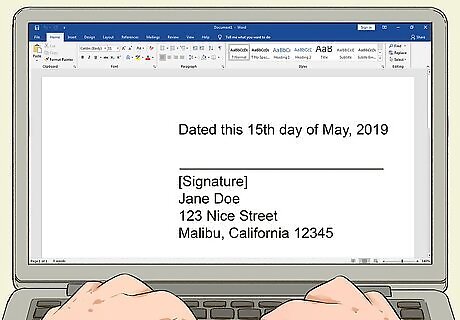
Sign and date your answer. After you've finished drafting your answer, proofread it carefully. You might even want to have someone else look over it for you. Any typos or other errors could have legal significance and greatly impact your case. When you're satisfied that your answer is error-free, print it and sign it in blue or black ink. Write the date that you plan to file it with the clerk as the date it was signed. After signing your answer, make at least 2 copies. You'll need one copy for your records and another to deliver to the plaintiff. If there are other people involved in the case, you'll need a copy for each of them as well.

Complete a certificate of service form. The clerk's office will have certificate of service forms. You can also typically download them from the website for your state's courts. The certificate of service form is the same for every case filed in court. On the certificate of service form, write the name and address of the plaintiff (or their attorney) as it appears on your summons. This is where you'll have to deliver a copy of your answer after it's filed.
Filing Your Answer

Contact the clerk's office of the court where the lawsuit was filed. You'll find a phone number and address for the clerk's office on your summons. The clerk will be able to tell you exactly what documents you should file with your answer and whether any filing fee is required. The clerk will also tell you how to file your answer. In most cases, it's best to take your original answer and copies to the clerk's office in person. However, you may also be able to file electronically online or mail your documents to the clerk's office. Some courts only allow electronic filing.

Take your written answer to the clerk's office. If you've decided to take your answer to the clerk's office in person for filing, bring your originals plus at least 2 copies. The clerk will take your documents and stamp each set of papers "filed" with the date. They will then give the copies back to you. One copy is for you to keep. The other copy you're responsible for delivering to the plaintiff (or their attorney). If you're filing electronically, keep your copy of any receipt that's generated indicating that your documents have been filed. If you're mailing your documents to the clerk's office, use certified mail with return receipt requested. When you get the card back with the date the documents were received by the clerk's office, you'll have proof of the date of filing. Double-check and make sure it's before the date of your deadline.Tip: Your answer must be filed by the deadline on your summons, not mailed by that date. If you're filing your answer by mailing the documents to the clerk's office, make sure you leave enough time before the deadline for your answer to get there.
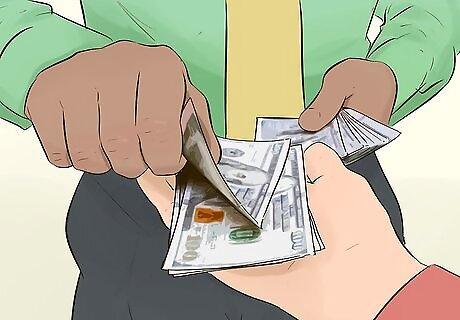
Pay the filing fees if necessary. Typically, you don't have to pay any filing fees simply to answer a complaint. However, if you have a counterclaim against the person who is suing you, there may be fees involved. The court clerk will tell you how much the fees are and what method of payment is accepted. Filing fees vary widely among courts and may depend on the value of your case. However, filing fees will rarely be more than $500. If you have a low income and can't afford the filing fees, ask the court clerk for a fee waiver application. You'll have to provide information about your income and assets. Courts waive filing fees for litigants with income and assets below a certain threshold. If you receive government benefits, such as SNAP or TANF, you likely automatically qualify for a fee waiver.
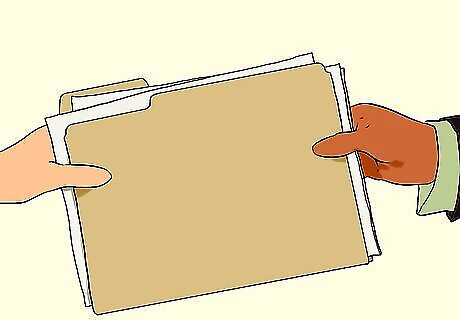
Have your written answer delivered to the person who sued you. You are responsible for "serving" the plaintiff with your answer to their lawsuit. However, it's typically not necessary to hire a sheriff's deputy or private process-serving company to hand-deliver the documents to them. Usually, you can mail the documents using certified mail with return receipt requested. When you get the card back indicating that the documents have been delivered, that constitutes proof that the plaintiff was served with your documents. The name and address of the person you need to send your answer to will be listed on your summons. It will either be the person who sued you or their attorney. If the plaintiff hired an attorney, make sure the documents go to them and not to the plaintiff directly. If you need to communicate with the plaintiff in any way, do so only through their attorney.



















Comments
0 comment